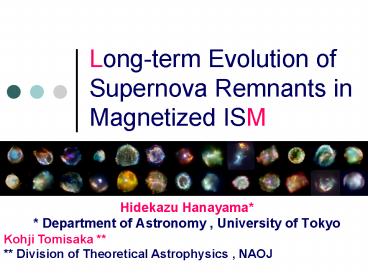Longterm Evolution of Supernova Remnants in Magnetized ISM - PowerPoint PPT Presentation
1 / 5
Title:
Longterm Evolution of Supernova Remnants in Magnetized ISM
Description:
Division of Theoretical Astrophysics , NAOJ. What is supernova remnant ? The massive star explodes greatly at the end of lifetime. ... – PowerPoint PPT presentation
Number of Views:35
Avg rating:3.0/5.0
Title: Longterm Evolution of Supernova Remnants in Magnetized ISM
1
Long-term Evolution of Supernova Remnants in
Magnetized ISM
- Hidekazu Hanayama
- Department of Astronomy , University of Tokyo
Kohji Tomisaka Division of Theoretical
Astrophysics , NAOJ
2
What is supernova remnant ?
SNR 0509-67.5 by Chandra X-ray satellite
- The massive star explodes greatly at the end of
lifetime. - The great explosion makes a supernova remnant
(SNR). - The explosion forms a shock wave.
- The shock wave expands very fast ! 1000km/s
- The form is spherical and seems to be a ball.
- An internal temperature is very high. 106K!
Shock wave
Hot gas
spherical expansion
3
My research
- Theoretical evolutions of supernova remnants
(SNRs) in magnetic field with numerical
simulations - SNRs evolve in the interstellar magnetic field.
- 1D-MHD (Magnetic Hydrodynamics) simulation has
already done. But it didnt include the global
direction of the magnetic field. - I tried 2D-MHD simulation with more realistic
model.
1D Magnetic field lines
2D Magnetic field lines
?
Never known
Already known
4
Model Calculation2D cylindrical coordinates
Z-direction
Interstellar Medium 0.2cm-3,104K
Density 106years
Calculate region
2500 2500 grid2
250pc
Magnetic field lines B05µG
250pc
R-direction
Supernova explosion E051050erg
Ideal MHD equation with radiative cooling and
heating was solved
5
Resultsthe evolution of SNR after the radiative
cooling phase
Density
Shell
7104 years
106 years
3106 years
No magnetic field exists
Shell expands with Sonic velocity Vs
Bubble
Density
Shell
7104 years
106 years
3106 years
Magnetic field B05µG exists
Shell expands with Alfven velocity VA
Magnetic field lines
Bubble
Details are in the poster. Lets discuss!
Hot bubble turns to shrink due to the magnetic
pressure in shells.































